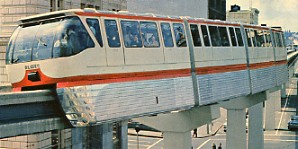Monorails can be fun, so long as they are properly maintained, operated, and ridden. Even so, unexpected twists on the beamway of life prove that sometimes it's just not fair, no matter how careful we are. Sure, monorail supporters point with pride to a generally good track record of safety, but a few monorail calamities have occurred. Though it has been spared of any jackings, head-on collisions, terrorist bombings, or Bernhard Goetz-styled vigilantisms, the monorail certainly hasn't been immune to its share of trouble.
The earliest (and perhaps most destructive) incident occurred on Pennsylvania's "Peg-Leg" monorailroad, one morning while the train was towing a flat wagon and a car full of passengers. On that fateful January 27, 1879, the boiler exploded on the 15-ton steam-powered locomotive, crashing the train into Foster Brook, killing the driver, the guy who stokes the boiler, and three passengers, and severely injuring everybody else.
The "Flying Lady" of New York's City Island Railroad, which used an overhead stabilizing rail, came to an unceremonious end in its first year of operation. One day in 1910, the motorman mistakenly took a curve too slowly, forcing the guide wheels out of the overhead rail, which was only designed to stabilize the car at higher speeds. The car crashed on its side, resulting in many injuries to the 100 passengers, and their subsequent lawsuits put the line out of business.
Germany's famed Wuppertal Schwebebahn was severely damaged by bombing during World War II and put completely out of commission in 1943, but by Easter 1946 it had been repaired and was back in action. As of 1963, the line had only had two of its one billion passengers injured over 60 years of operation. One of these incidents remains a mystery, but an odd 1952 incident involved a baby elephant who was secured passage by a circus promoter. Midway through the trip, the elephant, perhaps as uneasy about monorails as many urban planners, bolted through the car doors and fell 23 feet into the Wupper River below.
The German company Alweg boasted that only one of the eight million riders during the six-month run of Seattle's Century 21 World's Fair in 1962 filed an injury claim against them, yet the line's most serious accident occurred in 1971: the red train's braking system failed and it smashed into a steel girder at the Seattle Center station, injuring 26. Later, in March 1994, the red train stalled just 100 feet short of the Seattle Center terminal because of a chafed wire, accidentally triggering the train's emergency brakes. One-and-a-half hours elapsed before the last of 80 passengers descended firetruck ladders from 25 feet up. The Seattle Center director of operations personally apologized to each of them.
Terror at 20 feet: Perhaps the most bizarre monorail episode went down at Disneyland in June 1966. Nineteen year-old idiot Thomas Guy Cleveland of Northridge, California decided that rather than pay admission into the park, he would crawl in via the beamway. After scaling a fence to get on top of the beam, a security guard shouted a warning to him that the train was coming. Guy's desperate climb down onto a fiberglass canopy just below the track proved futile, as the clearance underneath was limited. Along came the train, hitting him, dragging him about 40 feet, and ultimately killing him. His remains were hosed off the beamway.
While emphasizing the more sordid aspects of monorailing, these accounts should not be misconstrued as portraying the typical ride as a potential death trip. Instead, monorails are exceedingly safe; very few have ridden the monorail to the grave. No doubt these stories are unfortunate, but collectively they only amount to a minor blemish on monorails' overall gleaming safety record.
